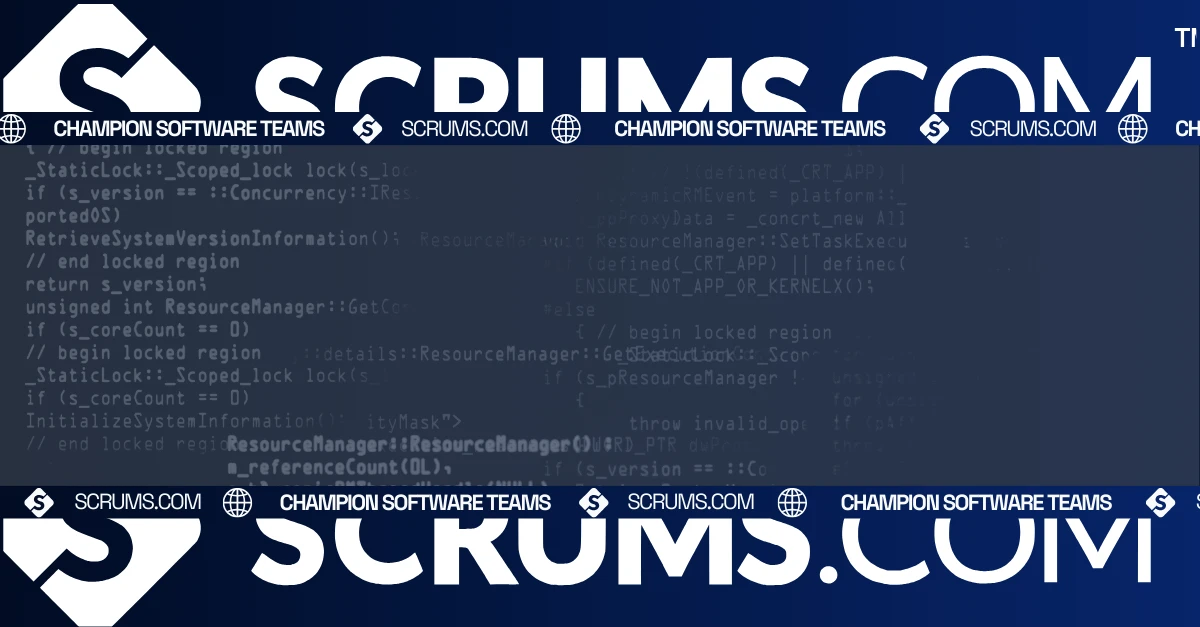How Much Does It Cost To Build An App?

Introduction to Custom App Development with Scrums.com: Flexibility for Every Business Need
App development is not a one-size-fits-all process, and neither are the costs involved. When investing in custom app development, factors such as feature complexity , platform support , and backend infrastructure play a central role in determining price.
At Scrums.com , we understand the importance of aligning your app’s features with business goals, ensuring you get the best results from your development investment. Whether you need to build a Minimum Viable Product (MVP) or a fully-featured enterprise solution, we leverage agile methodologies and our global talent network to deliver high-quality apps within your timeline and budget.
Key Points:
- Global Reach: Whether it’s engaging offshore or nearshore development teams, we offer flexibility in resource management.
- Agile Development: Iterative, feedback-driven processes ensuring alignment as your app develops.
- Tailored Scoping: Custom project exploration to fit your app's needs.
The Real Costs and Benefits of Custom App Development
Building a custom app offers advantages that off-the-shelf solutions simply cannot provide. However, understanding the cost factors in custom development empowers businesses to plan for viable, scalable solutions. Here, we break down the different factors that drive app development cost and show the long-term benefits of this investment.
Factors Driving Costs:
Feature Complexity:
Whether you’re building a basic MVP or a multifunctional eCommerce platform, the features you want significantly determine the time and resources required. More complex features (e.g., payment integrations, user authentication, geo-location) naturally increase development costs.
Supported Platforms:
Apps developed for iOS, Android, or cross-platform (React Native, Flutter) need different toolsets. Native development for each platform often provides better performance but can double the effort, whereas cross-platform solutions can streamline the process but might come with trade-offs.
User Interface (UI) Design:
Exceptional UX/UI design makes your app easy to use, visually appealing, and scalable. Developing a user-centric design takes extra design hours up front, but leads to better user flow, reducing post-launch development iterations and improving user satisfaction.
Backend Infrastructure:
Behind every app is a backend system managing data, functionality, and user requests. Advanced features (handling external APIs, complex databases) or apps requiring extensive data storage and processing tend to cost more due to the increased backend needs.
Benefits of Custom App Development:
Tailored to Your Business Needs:
A custom app is designed to specifically fit your operations, helping your business stand out by providing tailor-made solutions that standard off-the-shelf options can't match.
Scalability:
Custom development makes apps much more adaptable. As your business grows, you can add new features, expand into new platforms, or increase app performance, paving the way for long-term growth.
Future-Proofing:
Custom apps can easily integrate with internal systems or 3rd-party services as your business processes evolve, preparing your app to handle future technology trends or growing workloads.
Why Investment in Custom App Development Delivers Long-Lasting Value
Enhanced Custom Experience
Custom apps cater specifically to your user base. Instead of a generic solution, you can create personalized user experiences designed to optimize customer engagement and satisfaction.
Scalability
Every business grows. Custom apps scale up to match your business needs, allowing for feature expansion, new integrations, and adapting to higher user loads as you add more customers or services to your operation.
Full Data Ownership
Unlike relying on third parties, custom apps give you full control over your data. This lets you leverage analytics to make smarter business decisions and build features with data-driven insights.
Business Automation
Automating repetitive tasks is not only a time-saver but a cost-saver. Custom apps allow for business automation of key workflows, freeing up human resources to focus on higher-value activities.
Competitive Positioning
A custom-built app defines your brand’s uniqueness. Its coding, design, and workflow can’t be mirrored by competitors using off-the-shelf apps, giving you differentiation in the market.
The Total Cost of Owning an App: It’s More Than Development
Beyond initial development, apps require ongoing investment. The Total Cost of Ownership (TCO) includes updates, maintenance, support, hosting infrastructure, and cybersecurity. Ensuring long-term app performance means planning beyond the launch, factoring in regular maintenance and updates as your app grows.
- Initial Development Costs:
These include the time and resources spent on planning, design, development, and testing. This first phase defines your app’s foundations and determines its launch-readiness. - Ongoing Maintenance:
Every app requires routine bug fixes, operating system updates (like frequent iOS and Android upgrades), and optimizations based on real-world performance. - Cloud Hosting & Infrastructure:
Whether you’re on AWS, Google Cloud, or another cloud-based platform, hosting costs scale based on the data flow, storage needs, and traffic levels your app processes over time. - Support & Updates:
As your app scales, more post-launch support becomes necessary (e.g., security patches , compliance updates). This avoids expensive setbacks like security breaches down the road.
Related Article
TCO of Nearshore vs. Offshore vs. Onshore Outsourcing
Discover the TCO of nearshore, offshore, and onshore outsourcing models to optimize your software development costs.
How to Save on Your App Development Without Sacrificing Quality
- Start with an MVP (Minimum Viable Product):
Launching with an MVP allows you to get your app into the hands of users ASAP, then iterate with real-time feedback. This approach helps avoid unnecessary features or sunk costs when certain features aren't resonating with users. - Lean into Agile Development:
Developing your app in iterations allows flexibility in light of new priorities or user feedback. Staggered development keeps costs manageable and ensures you get high-priority features live first. - Nearshore and Offshore Resourcing:
Work smarter, not harder. Engage with a globally distributed talent pool to balance quality and cost. Tapping trusted global development partners is a common way to cut project costs without sacrificing app quality. - Avoid Feature Creep:
Stick with core features first . Bells and whistles can wait for phase two. A commitment to app focus prevents your project budget from spiraling out of scope.
How to Measure ROI in Custom App Development
Immediate Cost Savings:
Custom app development often digitizes and automates manual, repetitive tasks, reducing operational overhead significantly. Once implemented, these savings can be tracked as part of your personal ROI calculation.
Enhanced Retention & Lifetime Value:
Custom experiences lead to increased user retention. Apps that engage users via intuitive workflows and personalized content convert better, increasing customer LTV (Lifetime Value).
Data-Driven Insights:
Your custom app’s data is a goldmine. Sophisticated tracking and analytics give your business tailored insights into customer behavior, preferences, and potential pain points, arming you with data to make better business decisions.
Wondering What It Costs to Build A Popular App Like...?
Many businesses wonder what the development costs are for leading apps like Uber, Instagram, or Spotify. What features make them so successful, and what should you consider when building a similar app?
We’ve compiled detailed breakdowns of popular apps—giving you a glimpse into what goes behind the price tag for building industry giants. Learn more about each app’s essential features and how to strategically plan development for similar functionality.
Adapting Your App Over Time: The Long-Term Costs & Benefits
The best apps continuously adapt to user needs, technological changes, and shifting markets. Evolving your app means you’ll need to invest in periodic updates—a cost with long-term rewards.
Adapting your app keeps it relevant, ensures compatibility with operating systems, and maintains competitive positioning.
Why Adaptation is Necessary
Market Shifts : New trends and technologies (e.g., Artificial Intelligence (AI)/Virtual Reality (VR) create shifts in user expectations, often requiring new features or integrations to keep your app cutting-edge.
OS Updates & Compatibility : Constant updates from iOS and Android require apps to stay up-to-date or risk poor performance.
User Feedback & Continuous Optimization : Real users offer the best insights. By tapping into feedback, you can update poor features or introduce new functionalities.
Cost Factors for Adaptation
Redesigns & UI/UX Refresh : Regular UI refreshes keep your app visually relevant and functional as user interaction trends evolve.
Performance Optimizations : Scaling up your app requires optimizing how it handles heavier usage. Often, backend and database layers require optimization to prevent bottlenecks.
Benefits of Constant Adaptation
Business Growth : Creating an adaptable, scalable app ensures you’re always ready to meet growing demands.
Locking in User Loyalty : Apps that stay fresh and optimized increase user satisfaction and retention, thus increasing long-term value.
How Thoughtful UX/UI Design Reduces Long-Term Costs
A successful app isn't just about core functionality — it's about how users feel when they use it. A solid UX/UI foundation means less friction, fewer redesign needs, and a smoother user experience. If your app is intuitive and enjoyable, it blends seamlessly into your users’ daily lives — driving loyalty and reducing future support and development costs.
The Role of UX/UI in Cost Optimization:
- Initial Costs: A well-thought-out design can require additional time upfront for wireframes, prototypes, and user testing, but this early investment saves on costly rework.
- Low Support Needs: Well-designed apps reduce user confusion and frustration, minimizing the need for support tickets or customer service.
- Avoiding Full Redesigns: Great User Experience (UX) reduces the need for disruptive redesigns down the line, which might be needed if users are engaging poorly with initial designs.
Recent Trends Impacting UX/UI Costs:
- Micro-Interactions: These small, intuitive touches (like button animations or data-loading indicators) can make apps feel polished and reduce user friction.
- Minimalism & Performance: Clean, minimalist interfaces are in and align with better-performing apps, reducing unnecessary bloat.
Building Secure Apps for Today’s Data-Driven World
App security is more than just an add-on. It’s a critical aspect of modern app development that directly impacts user trust and legal compliance. Preventative security measures during development help avoid potential data breaches and expensive damage control later.
Key Security Areas:
Data Encryption:
All sensitive information should be encrypted both at rest and in transit. Encryption prevents unauthorized access and ensures secure communication between users and servers.
User Authentication:
Implement multi-factor authentication (MFA) to protect users and require role-based access for admins to control different levels of data and process access.
API Security:
APIs enable services to exchange data, but improperly secured APIs can be a point of vulnerability. Securing access points and API keys should always be part of your app development cost considerations.
Upfront Security Costs vs. Post-Breach Losses:
Investing upfront to develop security-focused apps avoids devastating recovery costs if a data breach occurs. A proactive approach to vulnerability management and regular updates keeps your app secure over its lifespan.
Compliance with Data Regulations:
Depending on global markets, you may need to comply with various standards like GDPR, HIPAA, or PCI-DSS, which adds complexity but also necessary protection from legal fallout.
Why Scalability Should Be Key to Any App Development Project
One of the biggest advantages of custom app development is the opportunity to plan for long-term scalability. Whether you're starting with an MVP or a launch-ready product, ensuring your app can scale with your business helps prevent costly rewrites or redevelopment efforts down the line.
Scalable Backend Architecture
Cloud Infrastructure: Building on cloud platforms like AWS or Google Cloud provides elastic, scalable server resources. As your user volume increases, cloud infrastructure allows the app to dynamically manage increased loads.
Microservices Architecture: Using a microservices architecture breaks down the app into smaller services, allowing each function (e.g., shopping carts, payments) to be scaled individually based on need.
Frontend Efficiency in Code
Performance Optimized Code: Clean and efficient code ensures that an increase in users doesn’t result in app performance slumps. Every feature needs to be created with performance in mind, prioritizing scalability.
Caching & Load Balancers: Use caching mechanisms and load balancers to reduce server stress and improve load times during heavy traffic periods.
Planning for New Feature Roll-outs
Modular design allows you to add new features seamlessly without disrupting the existing infrastructure. This flexibility prevents the app from needing complete overhauls every time a new feature or integration is introduced.
Costs of Scaling:
Backend optimizations, performance auditing, and upgrades to infrastructure as your user base grows should be factored into the development roadmap from day one.
Boost Your Capacity with Trusted Software Talent from Scrums.com
Scaling up app development at key moments is critical when aiming to meet deadlines. Scrums.com provides the agile global talent you need to build your app on time and within budget.
- Access to Global Talent Pools:
Whether you need specific skillsets in nearshore (U.S., UK) or offshore (Africa, Asia) developers, we source global talent that fits your budget and project requirements. - Flexible Staffing Models:
With Scrums.com’s flexible staffing , you can scale up your team to help meet workload surges (e.g., beta-testing/QA phases) or scale down as timelines progress. - Pre-Vetted Developers for Quality:
Trust our vetted professionals to integrate seamlessly with your timeline and goals, offering security, design, and development expertise where and when you need it most.
FAQs
We've got you covered, these are some common questions we receive. Not seeing the answer to something?...
Trusted by 400+ companies, Scrums.com helps businesses scale with our cloud-based engineering subscription platform, offering consistent, cost-effective custom software development, expert teams, and reliable developer analytics.
With 13 years of trailblazing delivery and an 8,000-strong talent pool, Scrums.com is the top English-speaking partner for growth-focused companies, agencies, and enterprises. Proudly born out of Africa, Scrums.com is now shaping the future of global AI-powered software development.
Scrums.com is here to ensure the talent you select is happy and performing. We offer quality developers at a cost-effective rate, utilizing African talent to help scale your business.
The Scrums.com policy is for our talent to work on pushing PR's into production on a sprint-by-sprint basis.We help balance time spent with output, all while ensuring quality. We incentivize our team members on performance and expect nothing less.
Your team will ensure at least 4 hours overlap over your working day, these hours, however, on request, can be discussed and tailored to ensure Scrums.com drives value for your business.
We offer upfront payments or 30-day payments with a selected frequency of monthly, quarterly, or yearly, depending on what best suits your business.
As a custom software development company, we offer you access to more than just a development team, you can select a team that encompasses all your SDLC needs.
From designers, business analysts, project managers and scrum coaches. Request it and we can build a team for you from the ground up.
The minimum subscription commitment is dependent on your package. You can either subscribe to a flexible contract that offers a minimum of 6 months or a fixed-term commitment of one year.
The one-year commitment comes at a significant cost reduction, as we at Scrums.com believe in and want to nurture longer-term relationships and have found that custom software development over time is best used to meet your ongoing development needs.
Our dedicated team will deepen its knowledge and understanding of your needs and preferences; the longer you work with Scrums.com the more value you're able to get.
Yes! We provide you with our recommendations, and you choose. In a quick, easy selection process that includes 3 steps, you will receive CVs and test results tailored to your culture requirements; you will meet them, and then they start. All within a maximum of 21 days!
Scrums.com focuses on selecting top-tier quality talent in Africa. The 8000+ talent has been vetted, tested, interviewed, and screened to ensure we adhere to our promise of cost-effective, quality talent.
Yes you will have a dedicated Account Manager and a dedicated HR manager to help navigate any questions, queries or performance issues you might have.
You will raise this with your dedicated Account Manager and we will understand why performance is below par. Should the talent not be well suited, Scrums.com will switch them out for you right away!This is to ensure continuity and drive performance for your business.
We are cloud-agnostic and focus on the following languages: Java, C#, Python, Javascript, Ruby, PHP, Swift, Kotlin, Go, C++, Rust, Scala, TypeScript, React, and Flutter.
Explore Software Development Blogs
The most recent trends and insights to expand your software development knowledge.






